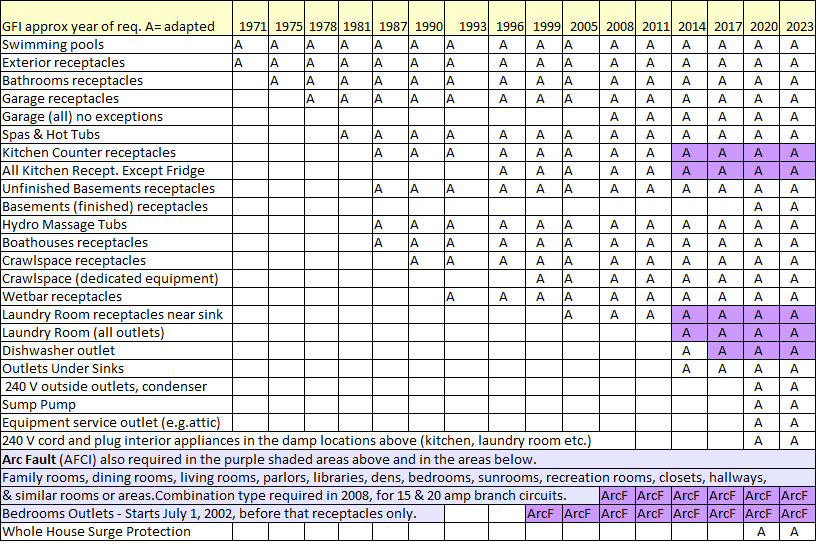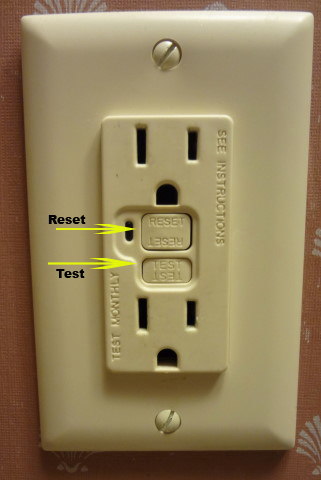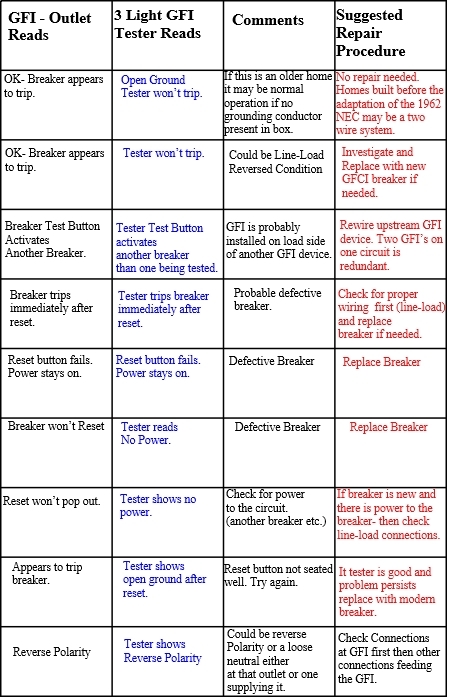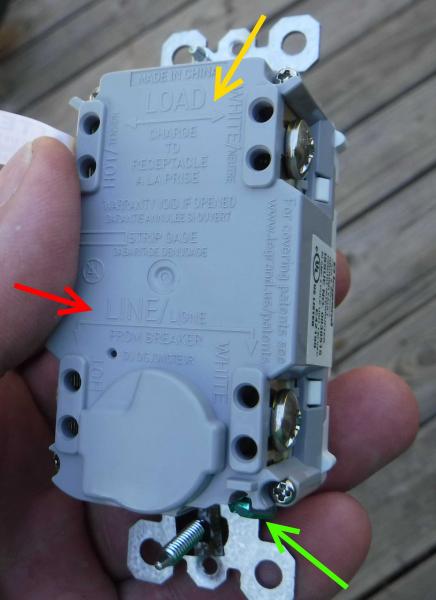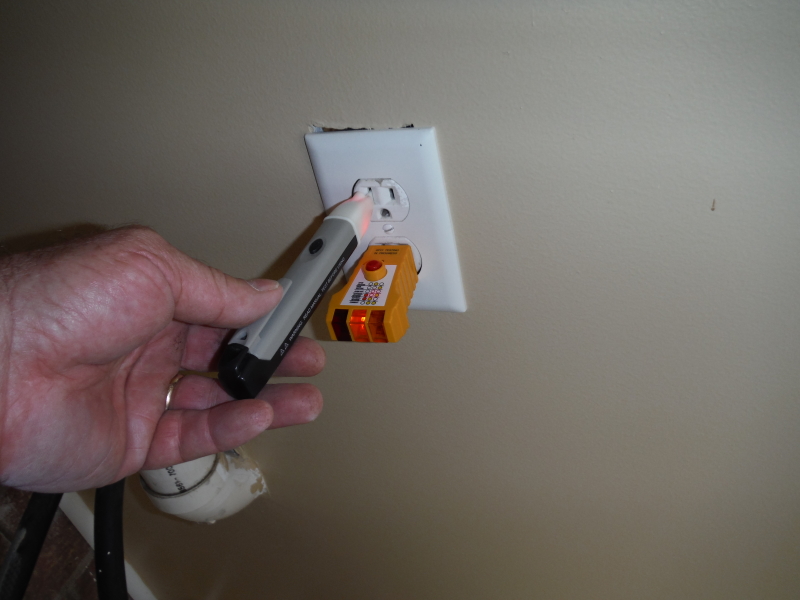A GFI or GFCI (ground fault interrupter, ground fault circuit interrupter) is a type of electrical receptacle which provides a greater measure of protection against electrical shock than a circuit breaker alone. It works by measuring the current flow on both the hot and neutral and it instantly cuts off the power if there is fault to ground or an imbalance. They are used where moisture is a possibility for safety purposes. As the years have passed they have been required in more and more places. While it is not required that anyone replace their existing outlets (unless you’re remodeling) it is a pretty good idea. It is also a good idea to test the ones you have occasionally to make sure they still work. Below is a chart that show the approximate date of inclusion into the NEC the requirement to install GFI’s. It is well to understand also that different jurisdictions adapt codes at different times ….sometimes years later so if you have a home built in ’76 for instance you still may not see GFI’s in the bathroom. Please consult the code books for the exact reference.
The chart below also lists AFCI (arc fault circuit interrupter) requirements. An AFCI is a type of circuit breaker that also protects against arc faults. Arc faults can happen for a variety of reasons, loose connections, nail piercing a wire, or defective equipment for instance. One example I saw is that one of the LEDs in a light bulb shorted out and was making the breaker flip. Arc fault breakers were originally only required in bedrooms but have been expanded to include almost every room. Since the requirement for combination type AFCI’s states that the protection must start at the origin of the circuit; most AFCI’s breakers are installed at the electrical panel when the home was built. They have been included in my chart below (in purple) because both types, GFC and AFCI’s are required in some locations. When a circuit breaker type of GFI or AFCI type breaker is installed at the panel it protects the whole circuit. So it negates the need for a point of use GFI. Although sometimes a point of use GFI is still installed for convenience reasons.
The chart below does not apply to manufactured homes (like mobile homes) as they are governed by a different standard.
In order to make the chart above easy to understand some nuances of the code requirements are not reflected in the chart above. There are particular requirements that have changed or indicate specific details. For instance one example would be the definitions of the words outlets and receptacles in the NEC. Outlets can be any device like a light fixture but a receptacle can only be the place where we plug something in. Consult the relevant code books if these nuances concerns you.
Also see the list of exclusions for your particular geographic area. South Carolina for instance has not adopted the provisions for GFCI protection for what they call 250 Volt outlets, whole house surge protection, AFCI protection for all kitchen and laundry areas. Also all outdoor outlets was excluded (receptacles still apply with some exceptions). Also some smaller jurisdictions might have their own ideas about how things should be done in their town.
Above is a picture of a typical ground fault circuit interrupter ( gfci ). They should be tested occasionally to make sure they still work. They also make a gfi circuit breaker that is installed into the panel box. they look like a regular circuit breaker with a reset button on the front to test them occasionally.
Ungrounded Wiring Systems
GFI’s can also provide protection on older ungrounded two slot receptacle locations that have no grounding conductor. In other words if an older two slot receptacle is changed out to the three slot (two plus ground) then it must be GFI protected. Must use the supplied label ” No Equipment Ground, GFCI protected” to identify that the circuit has no ground. Note – A standard GFI tester will not work on these outlets because there is no grounding conductor. In this case you have to use the test button on the GFI itself to test it. Grounding conductors at outlets have been required since the adaptation of the 1962 NEC.
Other Tips
Manufacturers recommend using the built in test button to test a GFI outlet. However after you’ve tested the GFI with the built in test button try using one of those three light testers as it can give you some clues as to what’s going on with the wiring. We recommend this procedure.
- First- Verify power to the outlet. A three button tester will work for this. Make sure there is nothing else plugged into the outlet you are testing.
- Second- Press the reset button on the GFI. Observe what happens.
- Third- Try using a three light tester on it. Observe what happens.
- Forth- Testing for GFI protection can tell you what is going on in a circuit. For example if the dishwasher stops then you’ll know that it is on the same circuit as the counter top circuit for example.
GFCI Troubleshooting Chart
Below is a handy chart to help diagnose a GFCI receptacle that test out as bad.
About Line Load Reversal on a GFI
A GFI has to be wired correctly to work correctly. For instance if your tests indicate a line load reversal condition then the GFI being tested will not be protected although it may appear that it works when using the test button (often it activates another GFI located on the same circuit up stream). The load side is for feeding other outlets downstream of the GFI device. The line side is how power gets to the outlet. In this case there will still be power at the GFI with the test button. Note* GFI’s manufactured after 2003 cannot be reset at the GFI test location when there is a line load reversal condition thus indicating the cause of the malfunction. The problem could also be a miswired outlet on the same circuit somewhere. What ever the cause the main thing to remember is that on a grounded wiring system both the test button on the GFI and the tester should cause the GFI to trip. If it does trip but doesn’t reset then suspect line load reversal.
The other situation is when a GFI causes another GFI breaker to trip. This can be inconvenient because the GFI that trips may be in a remote location. In this case it means that there is a line to load reversal problem. Solution is to use the load side when wiring downstream GFI devices. So you must identify which conductors are feeding the circuit.
Picture above shows how the GFI is marked so it is obvious which side is the line side and load side. The load side (yellow) is for feeding other outlets downstream. In other words you must determine which wires feed the circuit and hook those up to the line side (red) to supply the first GFI. Do this by disconnecting the old outlet and wire nut the ends of the conductors to isolate them and then turn the power on to find the “hot conductor” using a suitable tester. Then turn the power off again to wire the outlet with your new knowledge.
Testing Outlets
A three light tester will only test for one condition at a time. In the case above two defects exist. So it is a good idea to double check an outlet with a non contact voltage tester if the three light tester indicates a miswire. In the example at above a non contact voltage tester was used with a three light tester to determine a reverse polarity condition and an open ground condition. The hot slot is supposed to be the smaller of the two and the non contact voltage tested correctly identified the problem. This deficiency is actually fairly common on older homes. Also the diagnosis that the three light tester gives is not always right. Though it does indicate that the outlet is wired incorrectly, really the outlet should be pulled out to determine the reason the tester gave its reading.

